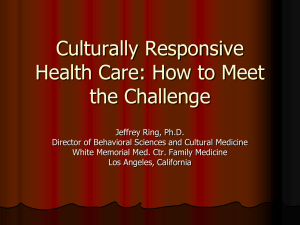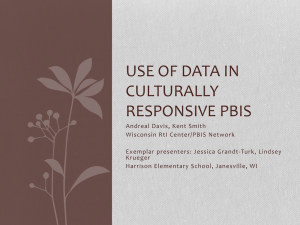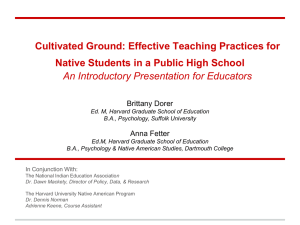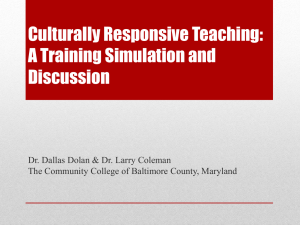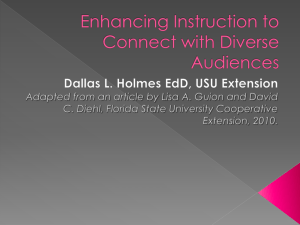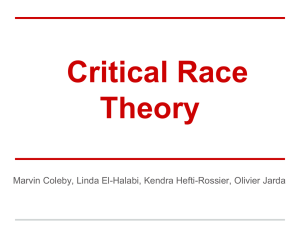Culturally Responsive Teaching
advertisement
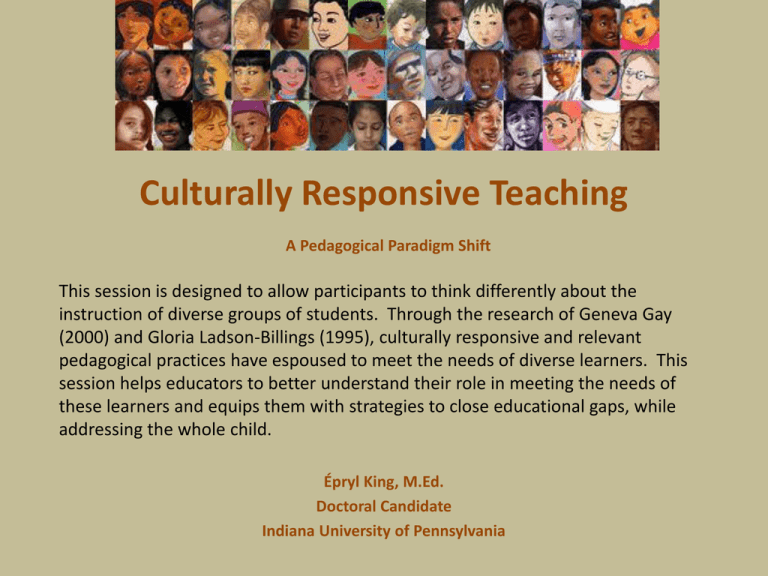
Culturally Responsive Teaching A Pedagogical Paradigm Shift This session is designed to allow participants to think differently about the instruction of diverse groups of students. Through the research of Geneva Gay (2000) and Gloria Ladson-Billings (1995), culturally responsive and relevant pedagogical practices have espoused to meet the needs of diverse learners. This session helps educators to better understand their role in meeting the needs of these learners and equips them with strategies to close educational gaps, while addressing the whole child. Épryl King, M.Ed. Doctoral Candidate Indiana University of Pennsylvania Why Culturally Responsive Teaching? And why me? • 2006, Masters, Gannon Univ. - Black/White Achievement Gap Focus • Countywide Professional Development, Closing Achievement Gaps • Contact/collaboration with University of Pittsburgh, Duquesne University, Harvard University • Communication with PSEA leadership, Legislative, MAC Committees • Research Advisory Committees, Pitt, IUP • PSEA Northwest Regional, Minority Leadership Conferences, Gettysburg • NEA/RA, Washington DC • Founding of non-profit, RAMP (Raising Achievement in Monroeville and Pitcairn, Inc.) • Presentations – • International Conference at University of Pittsburgh • Kennedy School of Government, Harvard University • PA-NAME (National Association of Multicultural Education), Millersville Univ. • Dissertation Focus Differentiated Instruction • Interest • Readiness • Learning profile Culturally Responsive Teaching • Interest • getting to know your students through their cultural background, and using that information to help them learn Agenda/Objectives • Understand the background/rationale for CRT • Identify characteristics of CRT • Apply characteristics of CRT to develop CRT lessons • Become equipped with to guide implementation of CRT resources Agenda/Objectives • Understand the background/rationale for CRT • Indications of differences by race • honors/AP courses • standardized test scores (NAEP, PSSA) • graduation rates • college entrance, matriculation rates • career/profession obtainment • wealth • health • conviction rates Agenda/Objectives • Understand the background/rationale for CRT from a historical perspective… How did inequities arise with diverse cultural groups? Historical Challenges of Being a Country with Diverse Ethnic Groups Early laws/court rulings enacted to marginalize minority groups • 1793, 1850 Fugitive Slave Act • 1790 Naturalization Act excluded Asians from naturalized citizenship • 1800 -1835 Southern States outlawed educating slaves to read and write • 1830 The Indian Removal Act • 1872 California school code provides no public education for any minority • 1882 Chinese Exclusion Law banned all Chinese workers from U.S. • 1896 Plessy Decision (separate but equal) • 1941 Internment of Japanese Americans into concentration camps (Nelson, Palonsky & McCarthy, 2010; Spring, 2010; NCLB 2001) Historical Challenges of Being a Country with Diverse Ethnic Groups Later laws which set to help minority groups • 1927 U.S. Supreme Court rules in favor of Japanese language in Hawaii schools • 1954 Brown vs. Board (ended segregation) • 1954 - Hernandez vs. Texas • 1961, 1965 Affirmative Action • 1965 Immigration Act – ended discrimination against Asians • 1968 Bilingual Education Act • 1970 Cisneros v. Corpus Christi (Brown vs. Board applied to Mexican-Americans) • 1972 Indian Education Act • 1974 Lau v. Nichols (guaranteed assistance for non-English speaking students to learn English) (Nelson, Palonsky & McCarthy, 2010; Spring, 2010; NCLB 2001) Agenda/Objectives • Understand the background/rationale for CRT • Indications of differences by race • honors/AP courses • standardized test scores (NAEP, PSSA) • graduation rates • college entrance, matriculation rates • career/profession obtainment • wealth • health • conviction rates Gateway’s 2012 PSSA Scores Mathematics All 77% White 82% Black 60% Hispanic 62% ED 68% IEP 44% Reading All White Black Hispanic ED IEP 78% 83% 60% 65% 66% 45% Gateway’s 2012 PSSA Scores Mathematics All 77% White 82% Black 60% Hispanic 62% ED 68% IEP 44% Reading All White Black Hispanic ED IEP 78% 83% 60% 65% 66% 45% Gateway’s 2012 PSSA Scores “There are virtually no racial or social class differences in mental ability among infants before their first birthday and a few social class indicators are able to explain the small differences that do exist.” – Harvard Achievement Gap Initiative http://www.agi.harvard.edu/projects/thegap.php Holistic Approach The body of research points to all stakeholders in an effort to close achievement gaps All Stakeholders • Parents • Teachers • Administrators • Community Holistic Approach The body of research points to all stakeholders in an effort to close achievement gaps All Stakeholders • Parents • Teachers • Administrators • Community Culturally Responsive Teaching Culturally Responsive Teaching “can be defined as using the cultural knowledge, prior experiences, frames of reference, and performance styles of ethnically diverse students to make learning encounters more relevant to and effective for them. It teaches to and through the strengths of these students” (Gay, 2000, p.29). Culturally Responsive Teaching… …is something that we already do, and for centuries has been directed at mainstream culture. • Pictures in textbooks • Choices of literature taught • Learning of scientist, inventors, musicians, theories, history • These have mostly appealed to mainstream (white, middle class) society. “Furthermore, culturally responsive teaching has the following characteristics:” • “It acknowledges the legitimacy of the cultural heritages of different ethnic groups, both as legacies that affect students’ dispositions, attitudes, and approaches to learning and as worthy content to be taught in the formal curriculum. “Furthermore, culturally responsive teaching has the following characteristics:” • “It acknowledges the legitimacy of the cultural heritages of different ethnic groups, both as legacies that affect students’ dispositions, attitudes, and approaches to learning and as worthy content to be taught in the formal curriculum. • It builds bridges of meaningfulness between home and school experiences as well as between academic abstractions and lived socio-cultural realities. “Furthermore, culturally responsive teaching has the following characteristics:” • “It acknowledges the legitimacy of the cultural heritages of different ethnic groups, both as legacies that affect students’ dispositions, attitudes, and approaches to learning and as worthy content to be taught in the formal curriculum. • It builds bridges of meaningfulness between home and school experiences as well as between academic abstractions and lived socio-cultural realities. • It uses a wide variety of instructional strategies that are connected to different learning styles “Furthermore, culturally responsive teaching has the following characteristics:” • “It acknowledges the legitimacy of the cultural heritages of different ethnic groups, both as legacies that affect students’ dispositions, attitudes, and approaches to learning and as worthy content to be taught in the formal curriculum. • It builds bridges of meaningfulness between home and school experiences as well as between academic abstractions and lived socio-cultural realities. • It uses a wide variety of instructional strategies that are connected to different learning styles • It teaches students to know and praise their own and each others’ cultural heritages. “Furthermore, culturally responsive teaching has the following characteristics:” • “It acknowledges the legitimacy of the cultural heritages of different ethnic groups, both as legacies that affect students’ dispositions, attitudes, and approaches to learning and as worthy content to be taught in the formal curriculum. • It builds bridges of meaningfulness between home and school experiences as well as between academic abstractions and lived socio-cultural realities. • It uses a wide variety of instructional strategies that are connected to different learning styles • It teaches students to know and praise their own and each others’ cultural heritages. • It incorporates multicultural information, resources, and materials in all the subjects and skills routinely taught in schools” (Gay, 2000, p29). Agenda/Objectives • Understand the background/rationale for CRT • Identify characteristics of CRT • Apply characteristics of CRT to develop CRT activities • Become equipped with resources to guide implementation of CRT Agenda/Objectives • Understand the background/rationale for CRT • Identify characteristics of CRT • Apply characteristics of CRT to develop CRT activities • Become equipped with resources to guide implementation of CRT Descriptive Characteristics of Culturally Responsive Teaching • • • • • • Is Validating Comprehensive Multidimensional Empowering Transformative Emancipatory How can I demonstrate culturally relevant teaching? Use cultural references • “using cultural referents to impart knowledge, skills, and attitudes” (Ladson-Billings, 1992, p.382). How can I demonstrate culturally relevant teaching? Use cultural references • “using cultural referents to impart knowledge, skills, and attitudes” (Ladson-Billings, 1992, p.382). • This is empowering and helps to combat the learned helplessness that permeates our many cultural groups How can I demonstrate culturally relevant teaching? The gravity of “CARING” • According to Ronald Ferguson (2002), the MSAN student survey of 2001 shows that AfricanAmerican and Hispanic students attributed their successes to “teacher encouragement” as opposed to “teacher expectations” to do well. How do I get to know my students’ cultural backgrounds better? Know and use your resources: •Internet, Journal Articles •Television and movies are one of the most impactful ways that people are socialized. Carefully select those that will inform you of historical and current cultural practices and values. • Text is wide and expansive. Magazines that espouse the general values of cultural groups are helpful…Ex. Jet, Ebony Magazines How can I demonstrate culturally relevant teaching? • Incorporate characteristics of CRT throughout instruction and across content areas (this is our main focus for today) How can I demonstrate culturally relevant teaching? • Use parents as resources and extensions of the educational team • Parents face many different challenges in educating their children. Many will benefit from your expertise in sending newsletters or other educational material home with students to help parents better support their children’s education at home How can I demonstrate culturally relevant teaching? • Include parents in the homework process (Epstein & Voorhis) – TIPS * 1x or 2x a month * Includes directions for parent * Student must interact with parent to complete the assignment * This helps promote student/parent interaction with homework What are some examples of successful schools? • 90/90/90 Schools (Douglas Reeves) – Dame-Dame Schools (University of Pittsburgh) • • • • 75% or more African-American 75% or more low-income backgrounds 75% or more proficient (Gold standard is 85% in all three categories, and proficient in both reading and math) What are some examples of successful schools? Name Enrollment City % Black % Poor Franklin Square Elementary (preK-5) 286 Baltimore MD 98.6 89.0 90.0 97.4 94.6 86.4 94.8 86.3 394 Baltimore MD 98.4 79.4 83.9 85.4 88.0 99.0 96.3 96.0 909 Columbus OH 90.7 78.3 90.8 89.9 KIPP Ujima Village Academy (5-8) Independence High (9-12) % At/Above in Reading Proficiency 2007 2008 2009 84.5 % At/Above in Math Proficiency 2007 2008 2009 83.7 76.3 75.1 What are some examples of successful schools? Locally Pittsburgh Public Schools (Fulton Academy) High percentage of African-American students High percentage of students from low-income backgrounds 2012 PSSA Scores All Students Math = 87% Black Students Math = 86% (n=113/129) All Students Reading = 62% Black Students Reading = 60% For Comparison 5 Year Trend in Reading PSSAs by Subgroup Gateway School District Overall Results (3-8, 11) Subgroup % Proficient White African American Hispanic 2007 2008 2009 74 76 82 45 51 58 64 50 65 2010 2011 82 84 62 65 43 63 For Comparison 5 Year Trend in Math PSSAs by Subgroup Gateway School District Overall Results Subgroup % Proficient White African American Hispanic 2007 2008 2009 73 77 83 45 49 59 59 68 59 2010 2011 86 84 66 69 67 75 For Comparison 2005 PSSAs in Math and Reading Moss Side Middle School Subgroup % Proficient White African American Hispanic 2005 Math 62 40 n/a 2005 Reading 73 47 n/a What does a culturally responsive classroom or lesson look like? Culturally Responsive Teaching and Learning (8:53), 2:40 – lesson example http://www.youtube.com/watch?feature=endscreen&v=_uOncGZWxDc&NR=1 * Introduction to Culturally Relevant Pedagogy (4:40) (1:08 – 3:00) (3:52-4:15) (Gay, 2000) http://www.youtube.com/watch?v=nGTVjJuRaZ8&feature=related * Gloria Ladson-Billings Cultural Competency (3:10) http://www.youtube.com/watch?v=ccEu7r2IwM0&feature=related What do the expert scholars say? Who are Culturally Competent Teachers? * Introduction to Culturally Relevant Pedagogy (4:40) (1:08 – 3:00) (3:52-4:15) (Gay, 2000) http://www.youtube.com/watch?v=nGTVjJuRaZ8&feature=related * Gloria Ladson-Billings Cultural Competency (3:10) ( :47-2:21) http://www.youtube.com/watch?v=ccEu7r2IwM0&feature=related * Culturally Responsive Teaching (Multiple Histories) – (3:00) http://www.youtube.com/watch?v=dKK2nuFxfbY Looking at multiple histories…how people change their trajectories What Culturally Responsive Teaching Is Not: • Standardized test prep – teaching students how to take test Culturally Responsive Teaching… • Immerses students in activities and contexts that are culturally meaningful and relevant. It builds bridges from that meaning to other contexts (text to text). It makes learning more efficient and teaching more effective. Because students have learned they will do better on tests. What does a sample culturally responsive lesson plan look like? Multicultural Curriculum – Fifth Grade Science/Math Lesson Plan: Egyptian hieroglyphs http://www.palmbeachschools.org/multicultural/documents/MultiFifth.pdf Diversity in Mathematics: Census Statistics in Utah http://www.uen.org/Lessonplan/preview.cgi?LPid=22271 What does CRT look like in different subjects? Reading: • authentic multicultural literature • skills areas situated within a cultural context Science, Math: • skills areas situated within a cultural context • contributions of different backgrounds reflected in lessons Social Studies: • minority perspectives reflected in historical accounts, key events, implications on today’s society What might a culturally responsive lesson plan look like using our KUD Lesson Plan Template? Second Grade Reading Comprehension Lesson: Character Agenda/Objectives • Understand the background/rationale for CRT • Identify characteristics of CRT • Apply characteristics of CRT to analyze or develop CRT lesson • Become equipped with resources to guide implementation of CRT Steps to developing a Culturally Responsive repertoire • First, get to know your students’ background • Identify cultures • develop relationships • talk to parents • use media resources • Draw from that knowledge to develop culturally responsive lessons. Culturally Responsive Teaching Resources Contributions of Minorities to United States Culture (quick examples) The Hispanic American.com http://www.thehispanicamerican.com/famous-hispanic-american/hisanicamerican-scientist-02/ http://www.thehispanicamerican.com/famous-hispanic-american/hispanicamerican-inventor-02/ Native American Scientists http://bio.sacnas.org/biography/listsscientist.asp Buzzle http://www.buzzle.com/articles/famous-black-mathematicians.html Contributions of Minorities to U.S. Culture Culturally Responsive Teaching Resources Contributions of Minorities to U.S. History (quick examples) Trail of Tears, Pt. 1 Documentary http://www.youtube.com/watch?v=aGBHAqur5YY&feature=related Slavery and the Making of America (Chapter 1) "The Capture" (clips from Amistad) http://www.youtube.com/watch?v=CsdosE10EjU&feature=related A Short History of Asians in America http://www.youtube.com/watch?v=6hVlSuuaQhs Hispanic Americans Univision: The New American Reality http://www.youtube.com/watch?v=pQnhuj11zgI Immigration to the United States, 1789-1930 (Harvard University Library) http://ocp.hul.harvard.edu/immigration/timeline.html Agenda/Objectives • Understand the background/rationale for CRT • Identify characteristics of CRT • Apply characteristics of CRT to analyze or develop CRT activities • Become equipped with resources to guide implementation of CRT Agenda/Objectives • Understand the background/rationale for CRT • Identify characteristics of CRT • Apply characteristics of CRT to analyze or develop CRT activities • Become equipped with resources to guide implementation of CRT Where can you find information about the cultures represented in your classroom? •Here’s a start. • Historical Contributions, Cultural History •Scientists, mathematicians, inventors • Representative Literature •Literature by and/or about the race/culture represented. Agenda/Objectives • Understand the background/rationale for CRT • Identify characteristics of CRT • Apply characteristics of CRT to analyze or develop CRT activities • Become equipped with resources to guide implementation of CRT Let’s put what we’ve learned into action! Develop a culturally responsive lesson plan K-4th Grade Teachers (Storytown Manuals) • Group by grade level if you can. • Select a major concept/skill in Reading and develop a culturally responsive Reading Lesson 5th-6th Grade Teachers (Either Storytown or Math Manuals) • Group by subject/grade area: • Reading • Math • Select a major concept/skill in Reading or Math and develop a culturally responsive lesson References Gay, G. (2000). Culturally responsive teaching: Theory, research, and practice. (pp. 29-36). New York, NY: Teachers College Press. Ferguson & Martin, 2009. The love to read survey. The Achievement Gap Initiative at Harvard University. Retrieved from: http://www.agi.harvard.edu/projects/lovetoread.php Ladson-Billings, G. (1992a). Culturally relevant teaching: The key to making multicultural education work. In C.A. Grant (Ed.), Research and multicultural education (pp. 106-121). London: Falmer Press. Ladson-Billings, G. (1992b). Liberatory consequences of literacy: A case of culturally relevant instruction for African-American students. Journal of Negro Education, 61, 378-391. Ladson-Billings, G. (1992c). Reading between the lines and beyond the pages: A culturally relevant approach to literacy teaching. Theory Into Practice, 31, 312-320. Ladson-Billings, G. (1995). But that’s just good teaching! The case for culturally relevant pedagogy. Theory Into Practice, 34, 159-165. Pennsylvania Department of Education. (2012, August 19). State Report Card 2010-2011. Retrieved August 19, 2012 from: http://paayp.emetric.net/Content/reportcards/RC11M.PDF Taylor, J., Orgass, S., Kouyatè, M., & King, E. (in preparation). A Gardening Metaphor: Framework for Closing and Reversing Racial Achievement Gaps in America. Department of Africana Studies, University of Pittsburgh, Pittsburgh, PA. Evaluation I value your feedback as to what could help make this presentation more effective in the future. Please take a moment to complete a short, anonymous evaluation of this session. Thank you. Épryl King, M.Ed., Doctoral Candidate Indiana University of Pennsylvania eprylking@achievementgap.info
